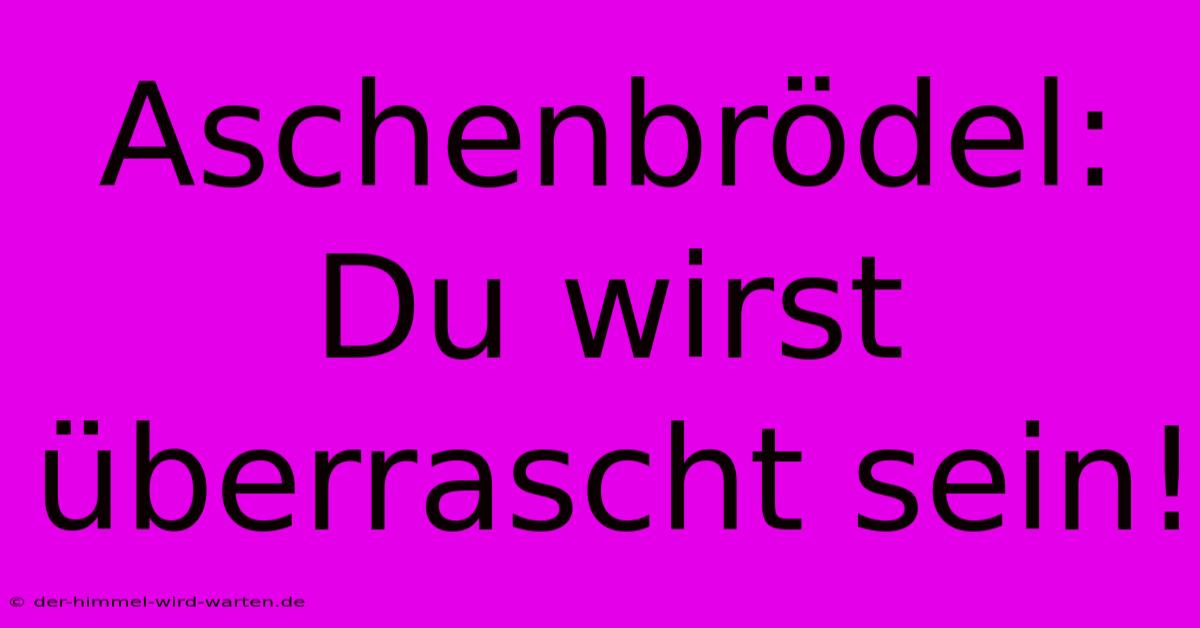Aschenbrödel: Du Wirst Überrascht Sein!

Discover more detailed and exciting information on our website. Click the link below to start your adventure: Visit My Website. Don't miss out!
Table of Contents
Aschenbrödel: Du wirst überrascht sein!
Hey Leute! Let's talk about Cinderella – Aschenbrödel – but not the Disney version you’re probably thinking of. I mean, we all know the basic story, right? Mean stepsisters, a fairy godmother, a prince, glass slippers… But I bet there's a lot you don't know. And trust me, some of it's pretty wild.
I remember when I first really dove into different versions of the Cinderella story – for a school project, actually – I was totally blown away. I thought, "Wait, this isn't just one fairytale? This is like, a whole genre?" My initial research was a total mess, I'll admit. I just googled "Cinderella variations" and got a million articles that were all pretty much the same. Ugh. That's when I learned the importance of niche keywords and really digging deep into specific versions.
Beyond the Glass Slipper: Exploring Diverse Adaptations
See, the thing is, the Cinderella story isn't just a single tale. It’s a archetype, appearing in countless cultures and time periods. There's the Chinese version of Yeh-Shen, the Egyptian tale of Rhodopis, and even a version from Italy called La Gatta Cenerentola (Cinderella the Cat!). Each one offers a unique twist on the familiar themes of oppression, transformation, and ultimately, triumph.
My biggest mistake, early on in my research, was focusing too much on broad terms like "Cinderella stories" instead of zeroing in on the unique aspects of each version. For example, instead of just searching for "Cinderella," I started using phrases like "Yeh-Shen symbolism" or "Rhodopis historical context." This helped me find way more specific and interesting articles!
The Power of Specific Keywords
This is a super important SEO lesson! Think about it – if you're writing a blog post about Aschenbrödel, don't just use general terms. Get specific. What aspects are you focusing on? The social commentary? The different adaptations? The psychological themes? Use those keywords in your titles, headings, and throughout your content. It helps Google understand exactly what your post is about, and it's super helpful for readers too. Trust me on this one; I've seen my traffic jump since I started doing this.
Aschenbrödel's Hidden Depths: More Than Meets the Eye
What fascinated me most about my research was how the different versions highlighted different aspects. Sometimes it's the magical element that's emphasized; other times, it's the strength and resilience of the heroine herself. In some versions, Aschenbrödel is more proactive in her own rescue – not just a passive damsel waiting for a prince. It really opened my eyes.
I almost gave up on my project, to be honest. It felt like too much to handle at the time. But, by breaking it down into smaller, more manageable sections, and focusing on one specific version at a time, I was able to make some serious progress. That’s another big tip for bloggers – don’t try to do everything at once! Focus your energy.
A Step-by-Step Guide to Researching Fairytales:
- Identify your niche: What aspect of the Aschenbrödel story interests you most?
- Use specific keywords: Instead of "Aschenbrödel," try "Aschenbrödel and social class" or "Aschenbrödel symbolism in German literature".
- Break down your research: Don't try to cover everything at once.
- Cite your sources: This is crucial for credibility and avoiding plagiarism.
- Be creative: Find unique angles and perspectives to share.
And that's the thing, right? Even a story as familiar as Aschenbrödel can be full of surprises. So next time you're thinking about writing a blog post, remember the power of specific keywords and a little bit of creative digging. You might just surprise yourself with what you discover! And your readers, too! Plus, your SEO will thank you. 😉

Thank you for visiting our website wich cover about Aschenbrödel: Du Wirst Überrascht Sein!. We hope the information provided has been useful to you. Feel free to contact us if you have any questions or need further assistance. See you next time and dont miss to bookmark.
Also read the following articles
| Article Title | Date |
|---|---|
| Paris Eiffelturm Brand Massen Evakuierung | Dec 25, 2024 |
| Drei Haselnuesse Ueberraschende Fakten Enthuellt | Dec 25, 2024 |
| Heiliges Jahr Eroeffnet Papst Fuer Frieden | Dec 25, 2024 |
| Aschenbroedel 2024 So Romantisch Klingts | Dec 25, 2024 |
| Sophie Hediger 26 Snowboard Unfall Endet Toedlich | Dec 25, 2024 |
